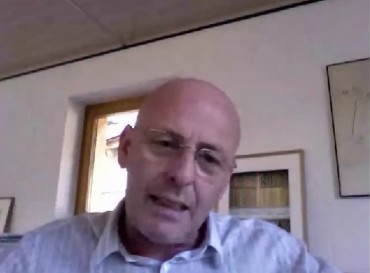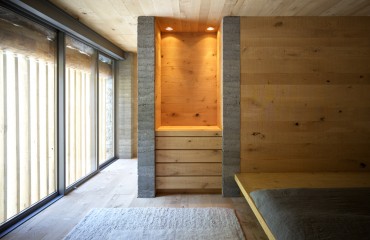Selected Topic
Issue 3 - On Giacometti – Physical and Cultural Landscapes in the Bergell (June 2011)
Show articles
Armando Ruinelli

Renovation of a stable in Soglio, 2009. Ruinelli Associatti Architetti

Renovation of a stable in Soglio, 2009. Ruinelli Associatti Architetti
4.7.2012 – Issue 3 - On Giacometti – Concheiro Isabel, Ruinelli Armando – Interviews
Architecture in the Bergell
Interview with Armando Ruinelli
How in your opinnion the strong physical and geographical conditions of Bregaglia influence the architecture of the valley?
There are some very strong elements, as the mountains and the shapes, these very stiff shapes. I live in Soglio, where the strong presence of the mountains is always in front of me, like a wall. Bregaglia is a little dark valley, an acute valley, very narrow, and certainly this has an immediate impact . It affects people’s psyche in general but certainly also affects the way architects work. How many of these elements are translated in a conscious way and how many just come out while designing, without realizing why? I think a valley, as in this case the Bregaglia valley, can have an influence in that way.
From the point of view of materials, if I think about concrete, I'm interested to see how is the concrete with the textures of the valley, with the gravel. I'm interested in the structure and surface of the mountains, but not directly because its close relationship with the stone as a construction material. I did also some buildings using chestnut tree wood because I live immediately above a chestnut tree. What interests me the most of a material is the patina, not the fact that it comes from the valley, rather how it reacts to the weather, how it behaves. I think a lot of influences of a valley or the place where one lives are on a subconscious level. A valley, as Bregaglia, one carries it inside, for better and for worse. It transmits you very strong sensations of light, of loneliness, of clear-obscure. I am not thinking about these things every time I make a project, but of course they influence the way I work.
Last semester students have developed a project for a Giacometti museum in Stampa. What do you think about the relationship between the projects and the context?
If we look at the projects that you did at the school, we can see two types of approaches. One is more urban, the student looks at the village, looks at the land of Stampa and reacts on the buildings that are there. There is another group of projects where the student looks at the valley, the mountains, the boulders, the large stones and creates like an image of a fallen mountain. There are these two approaches, the urban one, with the buildings that in a way react on the built environment and a second one that responds more to the geographical situation, the mountains, the landscape. At the bottom, they are two completely different and interesting ways of starting the project.
Which role do you think could play a Giacometti museum in the Bregaglia valley?
I think it's evident that a museum would be an amazing opportunity for a valley like ours. Of course, having here a Giacometti museum would have a very powerful impact in the valley and out of the valley, perhaps too strong. It would be necessary to foresee a range of interventions like the possibility of overnight stay, eating the organisation of traffic and all these things. Unlike other museums and cultural centers raised in the last years, in this case the potential would be enormous, because Giacometti is a global value. We know that there are very interesting museums that have been used only for a few years and later they have closed because there was not a strong content behind; even if the museum was made by a well-known international architect was not enough. We are architects and of course we are also interested in the envelop of the works but the most important thing for a museum is the content. Regardless of the fact that probably is not possible to fund it, not the building itself but the works, apart from that, it would be a wonderful thing, a Giacometti museum in Bregaglia.
Interview by Isabel Concheiro
Image credits (video)
- View to Sciora-Gruppe, Piz Cengalo and Piz Badile. Otto Furhter Verlag.
- View from Soglio. Photo by Isabel Concheiro.
- Stampa village. Foto Bernhardt, Huttwil.
- Project by Anna Ebneter. Chair Prof. Mateo, ETH Zurich.
- Project by Lea Stocker. Chair Prof. Mateo, ETH Zurich.
- Project by Rebecca Bornhauser. Chair Prof. Mateo, ETH Zurich.
- Project by Dario Wohler. Chair Prof. Mateo, ETH Zurich.
- Giacometti in the Stampa atelier. Das Bergell. Heimat der Giacometti. Verlag Scheidegger, Zurich, 1994.
- Buste de Diego,1952-53. Schriften, Fotos, Zeichnungen. Alberto Giacometti. Der Arche Verlag, 1958.
- Giacometti in the Paris atelier. Alberto Giacometti. Traces d'une amitié. Photos by Ernst Scheidegger. Maeght Editeur,1991.
- La place, 1948-49. Schriften, Fotos, Zeichnungen. Alberto Giacometti. Der Arche Verlag, 1958.
Download article as PDF

